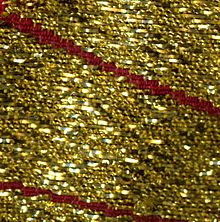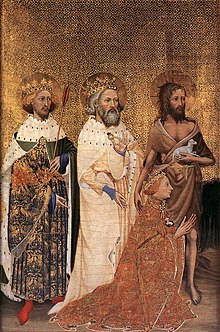
Cloth of gold or gold cloth (Latin: Tela aurea) is a fabric woven with a gold-wrapped or spun weft—referred to as "a spirally spun gold strip". In most cases, the core yarn is silk, wrapped (filé) with a band or strip of high content gold. In rarer instances, fine linen and wool have been used as the core.

Cloth of gold has been popular for ecclesiastical use for many centuries. Under Henry VII of England, its use was reserved to royalty and higher levels of nobility.[1] It is also used today by companies such as Charvet for neckwear.[2]
Few extant examples have survived in Roman provincial tombs.[3][4][5] Later producers of cloth of gold include the Byzantine Empire and Medieval Italian weavers, particularly in Genoa, Venice and Lucca.[6] Dating from the 1460s the Waterford cloth-of-gold vestments are made from Italian silk woven in Florence. The panels were embroidered in Bruges which was the centre of the medieval embroidery industry. A similar cloth of silver was also made. It is still made in India and Europe today.[7]
King Charles III re-used the Supertunica made from cloth of gold at his coronation on 6 May 2023. The full-length, sleeved coat is an important historic textile from the royal collection, weighing around two kilograms. It has been worn at several previous coronations in the United Kingdom.[8]